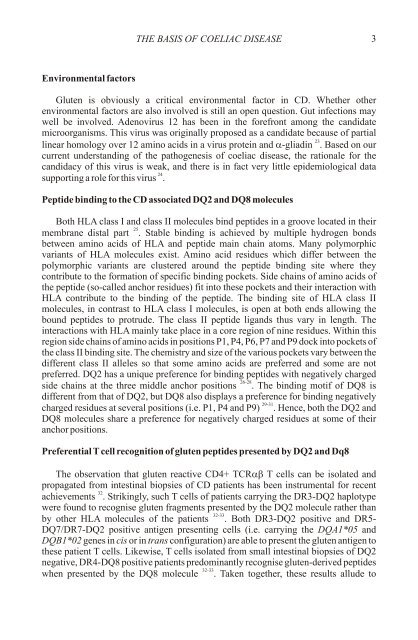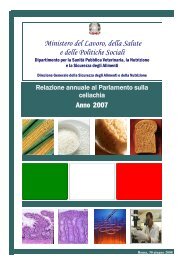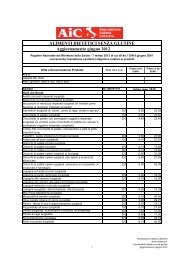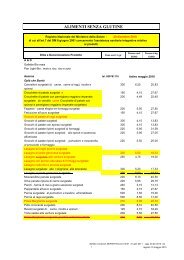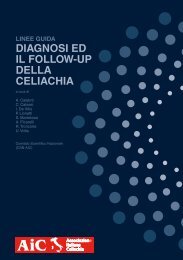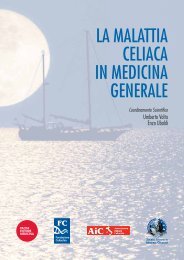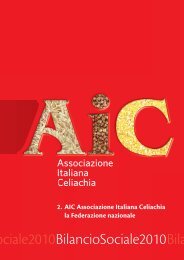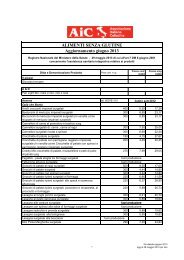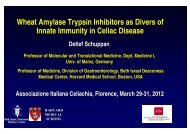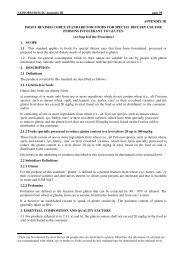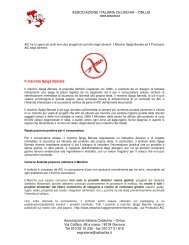primary prevention of coeliac disease - Associazione Italiana ...
primary prevention of coeliac disease - Associazione Italiana ...
primary prevention of coeliac disease - Associazione Italiana ...
You also want an ePaper? Increase the reach of your titles
YUMPU automatically turns print PDFs into web optimized ePapers that Google loves.
THE BASIS OF COELIAC DISEASE<br />
3<br />
Environmental factors<br />
Gluten is obviously a critical environmental factor in CD. Whether other<br />
environmental factors are also involved is still an open question. Gut infections may<br />
well be involved. Adenovirus 12 has been in the forefront among the candidate<br />
microorganisms. This virus was originally proposed as a candidate because <strong>of</strong> partial<br />
23<br />
linear homology over 12 amino acids in a virus protein and a-gliadin . Based on our<br />
current understanding <strong>of</strong> the pathogenesis <strong>of</strong> <strong>coeliac</strong> <strong>disease</strong>, the rationale for the<br />
candidacy <strong>of</strong> this virus is weak, and there is in fact very little epidemiological data<br />
24<br />
supporting a role for this virus .<br />
Peptide binding to the CD associated DQ2 and DQ8 molecules<br />
Both HLA class I and class II molecules bind peptides in a groove located in their<br />
25<br />
membrane distal part . Stable binding is achieved by multiple hydrogen bonds<br />
between amino acids <strong>of</strong> HLA and peptide main chain atoms. Many polymorphic<br />
variants <strong>of</strong> HLA molecules exist. Amino acid residues which differ between the<br />
polymorphic variants are clustered around the peptide binding site where they<br />
contribute to the formation <strong>of</strong> specific binding pockets. Side chains <strong>of</strong> amino acids <strong>of</strong><br />
the peptide (so-called anchor residues) fit into these pockets and their interaction with<br />
HLA contribute to the binding <strong>of</strong> the peptide. The binding site <strong>of</strong> HLA class II<br />
molecules, in contrast to HLA class I molecules, is open at both ends allowing the<br />
bound peptides to protrude. The class II peptide ligands thus vary in length. The<br />
interactions with HLA mainly take place in a core region <strong>of</strong> nine residues. Within this<br />
region side chains <strong>of</strong> amino acids in positions P1, P4, P6, P7 and P9 dock into pockets <strong>of</strong><br />
the class II binding site. The chemistry and size <strong>of</strong> the various pockets vary between the<br />
different class II alleles so that some amino acids are preferred and some are not<br />
preferred. DQ2 has a unique preference for binding peptides with negatively charged<br />
26-28<br />
side chains at the three middle anchor positions . The binding motif <strong>of</strong> DQ8 is<br />
different from that <strong>of</strong> DQ2, but DQ8 also displays a preference for binding negatively<br />
29-31<br />
charged residues at several positions (i.e. P1, P4 and P9) . Hence, both the DQ2 and<br />
DQ8 molecules share a preference for negatively charged residues at some <strong>of</strong> their<br />
anchor positions.<br />
Preferential T cell recognition <strong>of</strong> gluten peptides presented by DQ2 and Dq8<br />
The observation that gluten reactive CD4+ TCRabT cells can be isolated and<br />
propagated from intestinal biopsies <strong>of</strong> CD patients has been instrumental for recent<br />
32<br />
achievements . Strikingly, such T cells <strong>of</strong> patients carrying the DR3-DQ2 haplotype<br />
were found to recognise gluten fragments presented by the DQ2 molecule rather than<br />
32-33<br />
by other HLA molecules <strong>of</strong> the patients . Both DR3-DQ2 positive and DR5-<br />
DQ7/DR7-DQ2 positive antigen presenting cells (i.e. carrying the DQA1*05 and<br />
DQB1*02 genes in cis or in trans configuration) are able to present the gluten antigen to<br />
these patient T cells. Likewise, T cells isolated from small intestinal biopsies <strong>of</strong> DQ2<br />
negative, DR4-DQ8 positive patients predominantly recognise gluten-derived peptides<br />
32-33<br />
when presented by the DQ8 molecule . Taken together, these results allude to


